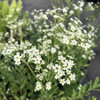Euphorbia corollata - FLOWERING SPURGE
A very tough native perennial, this plant is underused in American horticulture; however, it's becoming popular in European gardens. Flowering spurge is a great substitute for invasive non-native baby’s breath (Gypsophilla paniculata) as they are similar in appearance (unfortunately, it can't be used as a cut flower like baby's breath). Even better, this Euphorbia is much more adaptable to all types of soils and levels of moisture, and tolerates some light shade (half-sun, half-shade). Add the fact that it’s a superb pollinator and bird plant...you have a clear winner!
This is a clump-forming upright perennial that will spread wide by rhizomes, but still stay in clumps. Can be planted in border and pollinator gardens and will naturalize in wilder or prairie plantings. It looks great with the rough structure of Echinacea, Rudbeckia, Liatris, Coreopsis lanceolata, Oenothera, Helianthus mollis, lower-growing varieties of Helenium, Yucca,…. but also non-native Acanthus, Kniphophia, Peonia, Iris x germanica, etc. Abundant flowering perennial!
Blooming Time: June–August
Size: 3’ high x 1.5’-2 wide
USDA Zones: 3 to 9
Culture: Sun to half shade, very adaptable to any soils from clay to rocky, gravelly or sandy soils
Moisture Needs: also adaptable to moisture – from dry to medium, medium-moist
Origin: Native wildflower in central and eastern USA. Natural habitat includes disturbed or high quality natural areas such as black soil prairies, clay prairies, sand prairies, gravel prairies, dolomite prairies, hill prairies, openings in rocky or sandy woodlands, savannas, thinly wooded bluffs, limestone glades, sand dunes, roadsides, railroads, mined land, etc.
Deer/Rabbit Resistant: yes/yes due to toxic latex
Attracts Butterflies or Pollinators: attractive for many pollinators - many species of bees, wasps and smaller butterflies
Attracts Hummingbirds: no, but attracts many birds, including wild turkey, quail, mourning doves, greater prairie chicken, horned lark
Pot Size: 3.5" x 4" perennial pot (1.22 pt/580 ml)

Euphorbia corollata - FLOWERING SPURGE
A very tough native perennial, this plant is underused in American horticulture; however, it's becoming popular in European gardens. Flowering spurge is a great substitute for invasive non-native baby’s breath (Gypsophilla paniculata) as they are similar in appearance (unfortunately, it can't be used as a cut flower like baby's breath). Even better, this Euphorbia is much more adaptable to all types of soils and levels of moisture, and tolerates some light shade (half-sun, half-shade). Add the fact that it’s a superb pollinator and bird plant...you have a clear winner!
This is a clump-forming upright perennial that will spread wide by rhizomes, but still stay in clumps. Can be planted in border and pollinator gardens and will naturalize in wilder or prairie plantings. It looks great with the rough structure of Echinacea, Rudbeckia, Liatris, Coreopsis lanceolata, Oenothera, Helianthus mollis, lower-growing varieties of Helenium, Yucca,…. but also non-native Acanthus, Kniphophia, Peonia, Iris x germanica, etc. Abundant flowering perennial!
Blooming Time: June–August
Size: 3’ high x 1.5’-2 wide
USDA Zones: 3 to 9
Culture: Sun to half shade, very adaptable to any soils from clay to rocky, gravelly or sandy soils
Moisture Needs: also adaptable to moisture – from dry to medium, medium-moist
Origin: Native wildflower in central and eastern USA. Natural habitat includes disturbed or high quality natural areas such as black soil prairies, clay prairies, sand prairies, gravel prairies, dolomite prairies, hill prairies, openings in rocky or sandy woodlands, savannas, thinly wooded bluffs, limestone glades, sand dunes, roadsides, railroads, mined land, etc.
Deer/Rabbit Resistant: yes/yes due to toxic latex
Attracts Butterflies or Pollinators: attractive for many pollinators - many species of bees, wasps and smaller butterflies
Attracts Hummingbirds: no, but attracts many birds, including wild turkey, quail, mourning doves, greater prairie chicken, horned lark
Pot Size: 3.5" x 4" perennial pot (1.22 pt/580 ml)




